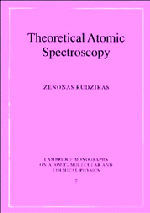Book contents
- Frontmatter
- Contents
- Preface
- Foreword to the Paperback Edition
- Introduction
- Part 1 Energy Spectrum of Many-electron Atom. Radiative and Autoionizing Transitions (Initial Formulas)
- Part 2 Foundations of the Angular Momentum Theory. Graphical Methods
- Part 3 Description of Complex Electronic Configurations
- Part 4 Second-quantization in the Theory of an Atom. Quasispin and Isospin
- Part 5 Matrix Elements of the Energy Operator
- Part 6 Electric and Magnetic Multipole Transitions
- Part 7 Calculation of Energy Spectra and Electronic Transitions in the Case of Complex Configurations
- 28 Methods of determination of radial orbitals
- 29 Correlation effects. Perturbation theory
- 30 The role of gauge dependence, relativistic and correlation effects in electronic transitions
- 31 Peculiarities of the structure and spectra of highly ionized atoms
- 32 Global methods in the theory of many-electron atoms
- 33 Peculiarities of configurations with vacancies in inner shells
- Epilogue
- References
- Index
29 - Correlation effects. Perturbation theory
Published online by Cambridge University Press: 21 September 2009
- Frontmatter
- Contents
- Preface
- Foreword to the Paperback Edition
- Introduction
- Part 1 Energy Spectrum of Many-electron Atom. Radiative and Autoionizing Transitions (Initial Formulas)
- Part 2 Foundations of the Angular Momentum Theory. Graphical Methods
- Part 3 Description of Complex Electronic Configurations
- Part 4 Second-quantization in the Theory of an Atom. Quasispin and Isospin
- Part 5 Matrix Elements of the Energy Operator
- Part 6 Electric and Magnetic Multipole Transitions
- Part 7 Calculation of Energy Spectra and Electronic Transitions in the Case of Complex Configurations
- 28 Methods of determination of radial orbitals
- 29 Correlation effects. Perturbation theory
- 30 The role of gauge dependence, relativistic and correlation effects in electronic transitions
- 31 Peculiarities of the structure and spectra of highly ionized atoms
- 32 Global methods in the theory of many-electron atoms
- 33 Peculiarities of configurations with vacancies in inner shells
- Epilogue
- References
- Index
Summary
Methods of accounting for correlation effects
Correlation effects have already been mentioned a number of times. Let us discuss them here in more detail. In the Hartree-Fock approach (to be more exact, in its single-configuration version, which we have been considering so far) it is assumed that each electron in an atom is orbiting independently in the central field of the nucleus and of the remaining electrons (one-particle approach). However, this is not exactly so. There exist effects, usually fairly small, of their correlated, consistent movement, causing the so-called correlation energy.
In the language of quantum numbers it may be explained in the following way. Only the parity of the configuration and total angular momentum are exact quantum numbers. From the parity conservation law it follows that the energy operator matrix elements connecting configurations of opposite parity vanish. Matrix elements of the one- and two-particle operators (the operators we are considering in this book) also vanish if they connect wave functions of configurations differing by the quantum numbers of more than one and two electrons, respectively. However, the non-diagonal with respect to configurations matrix elements of, for example, an electrostatic interaction, are in general non-zero. Hence, the configuration, considered as a quantum number, is not always an exact quantum number, and then a single-configuration approach is not sufficiently accurate. For this reason, while forming the energy matrix, non-diagonal, with respect to configurations, matrix elements must also be accounted for.
- Type
- Chapter
- Information
- Theoretical Atomic Spectroscopy , pp. 346 - 356Publisher: Cambridge University PressPrint publication year: 1997



